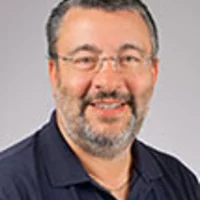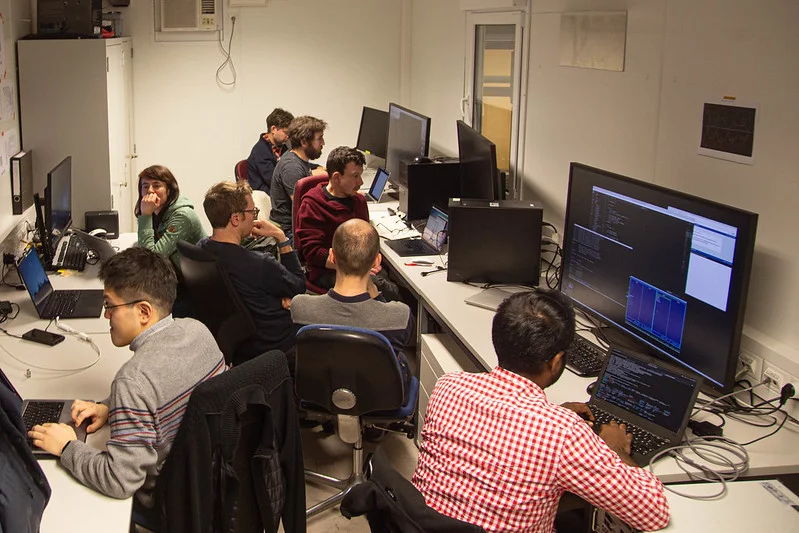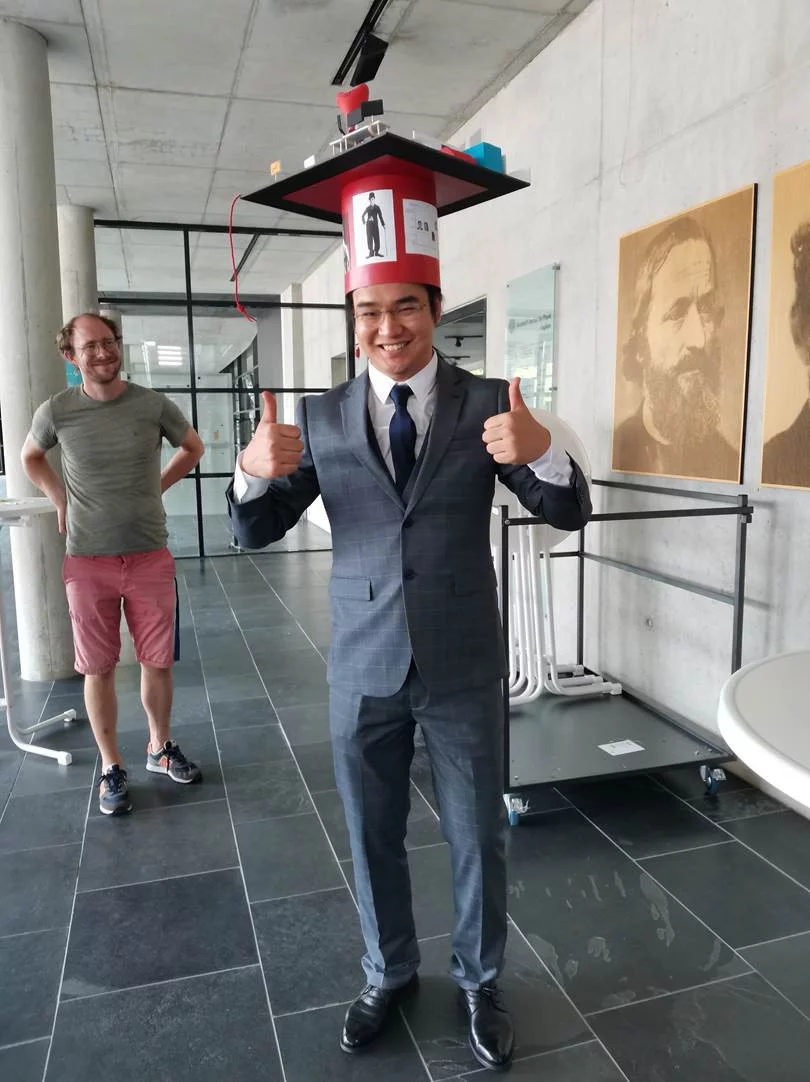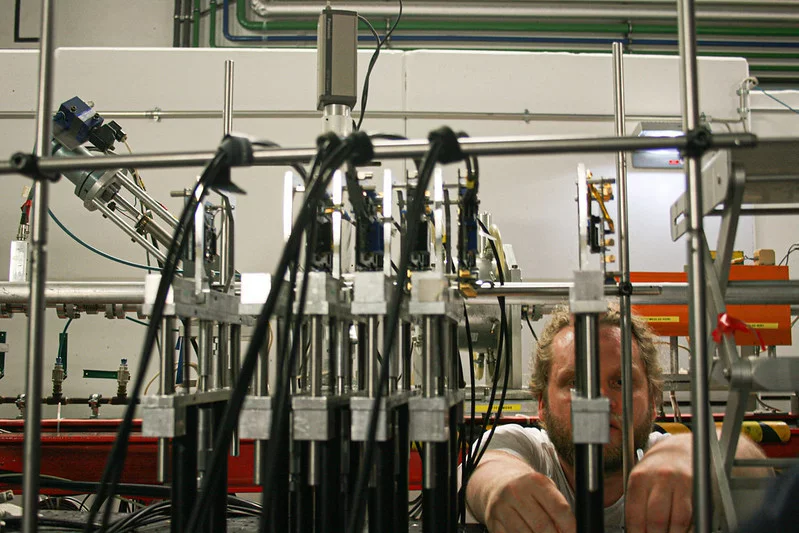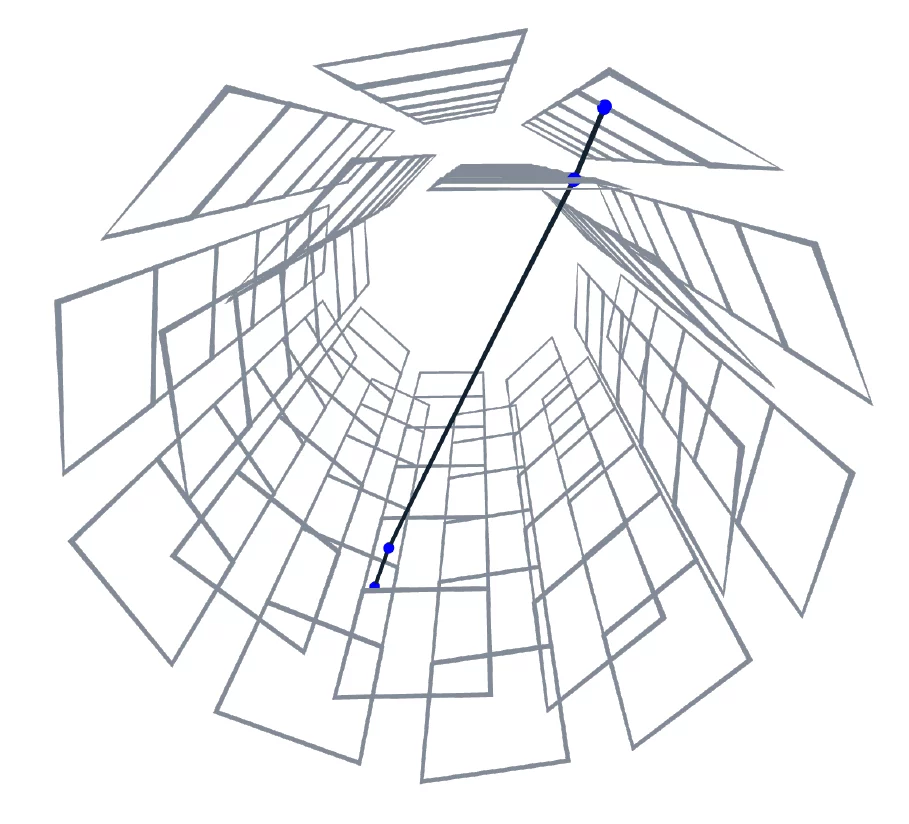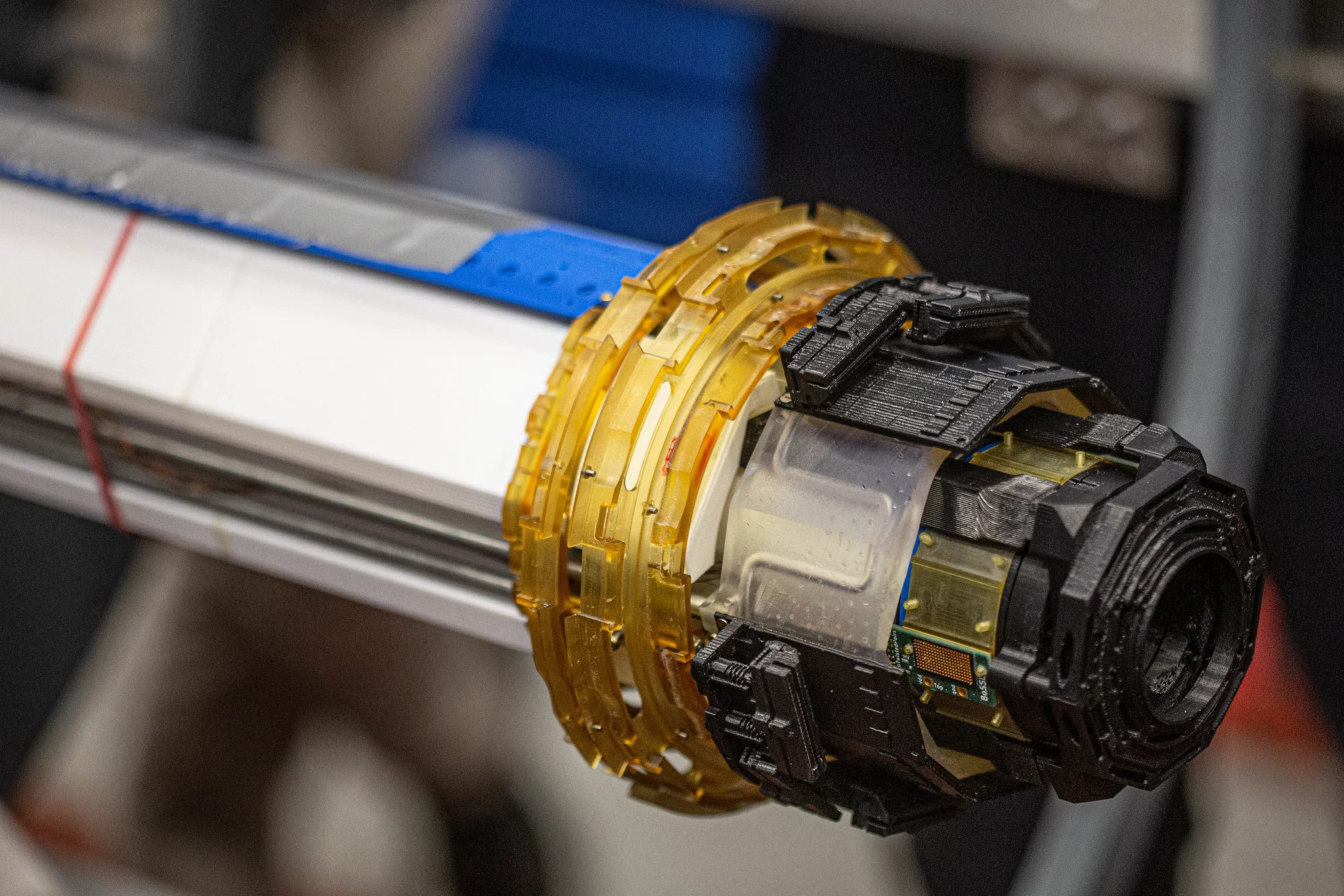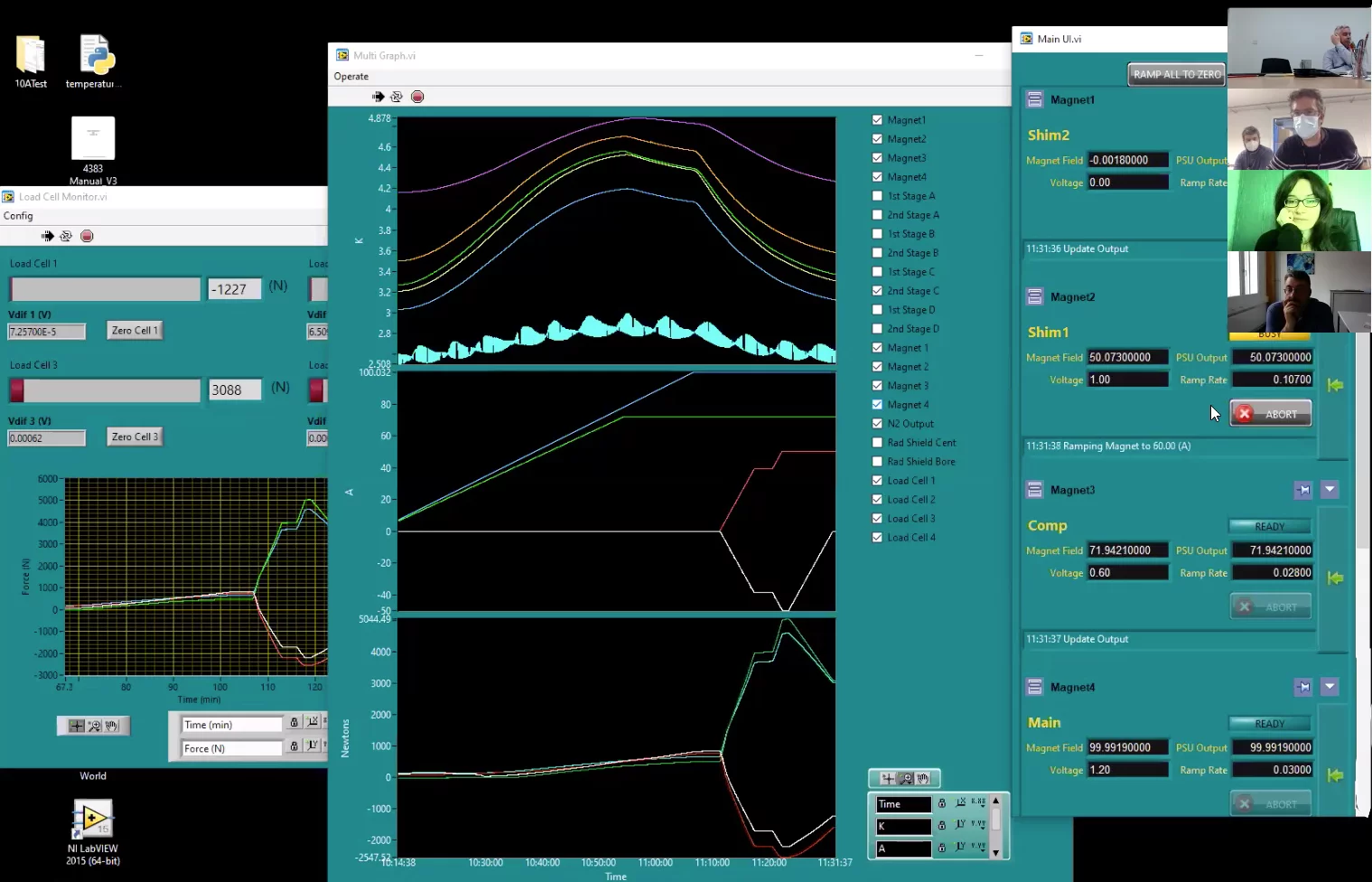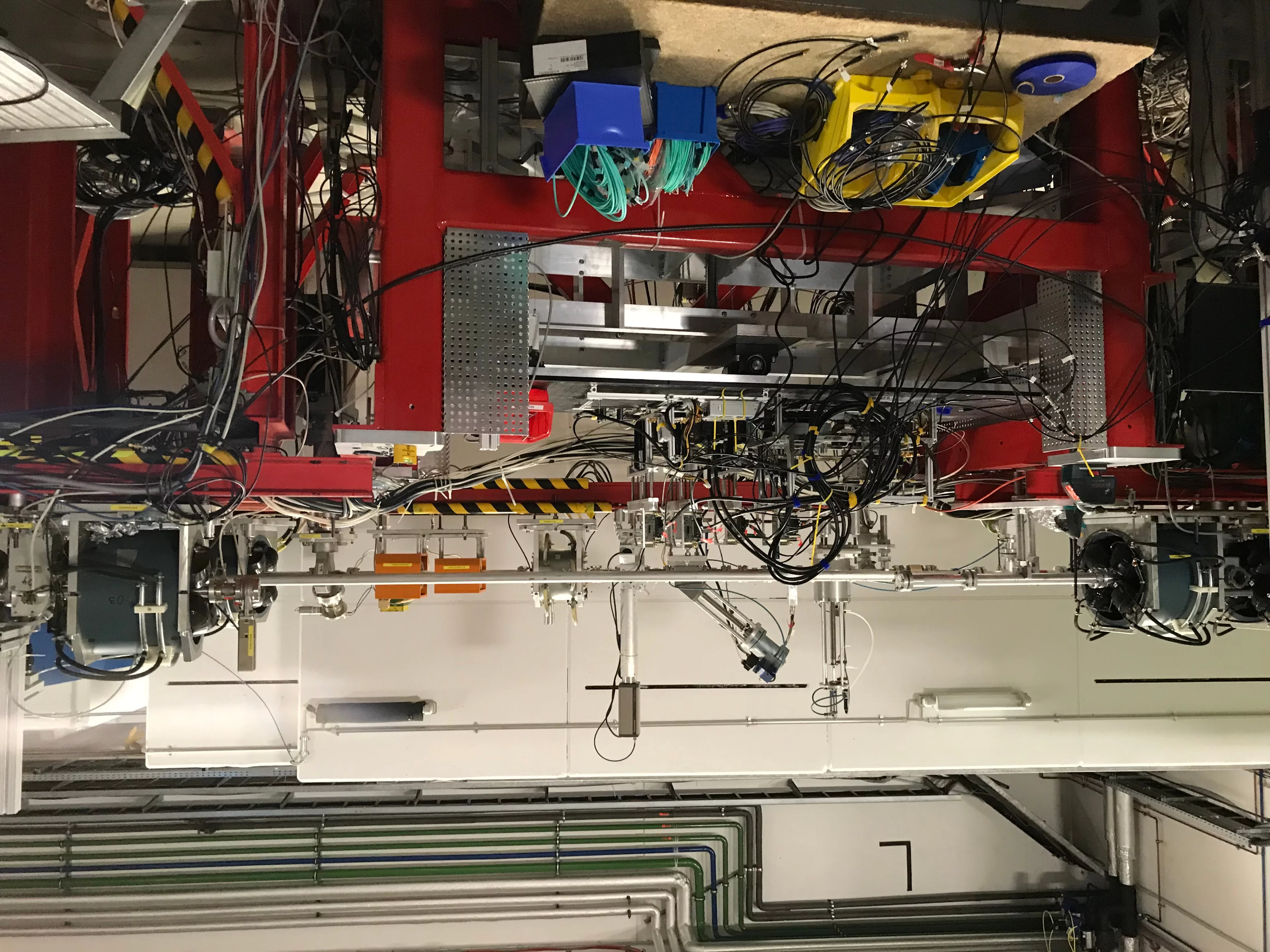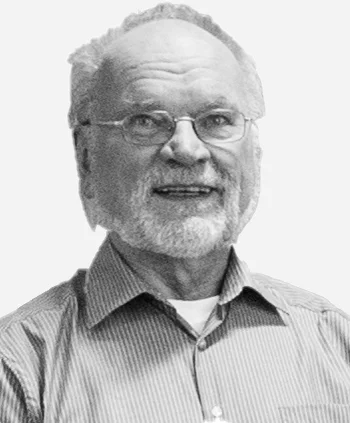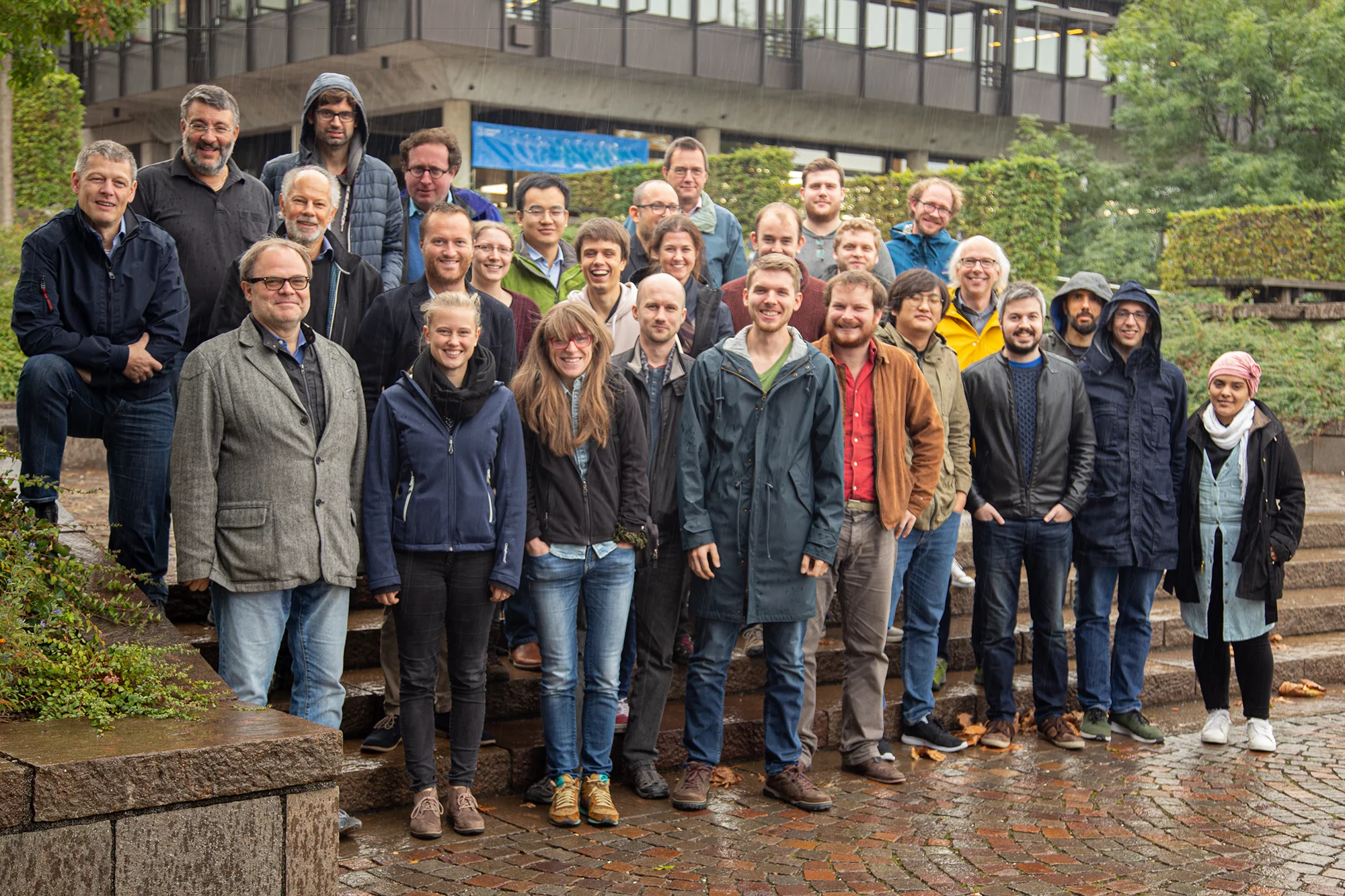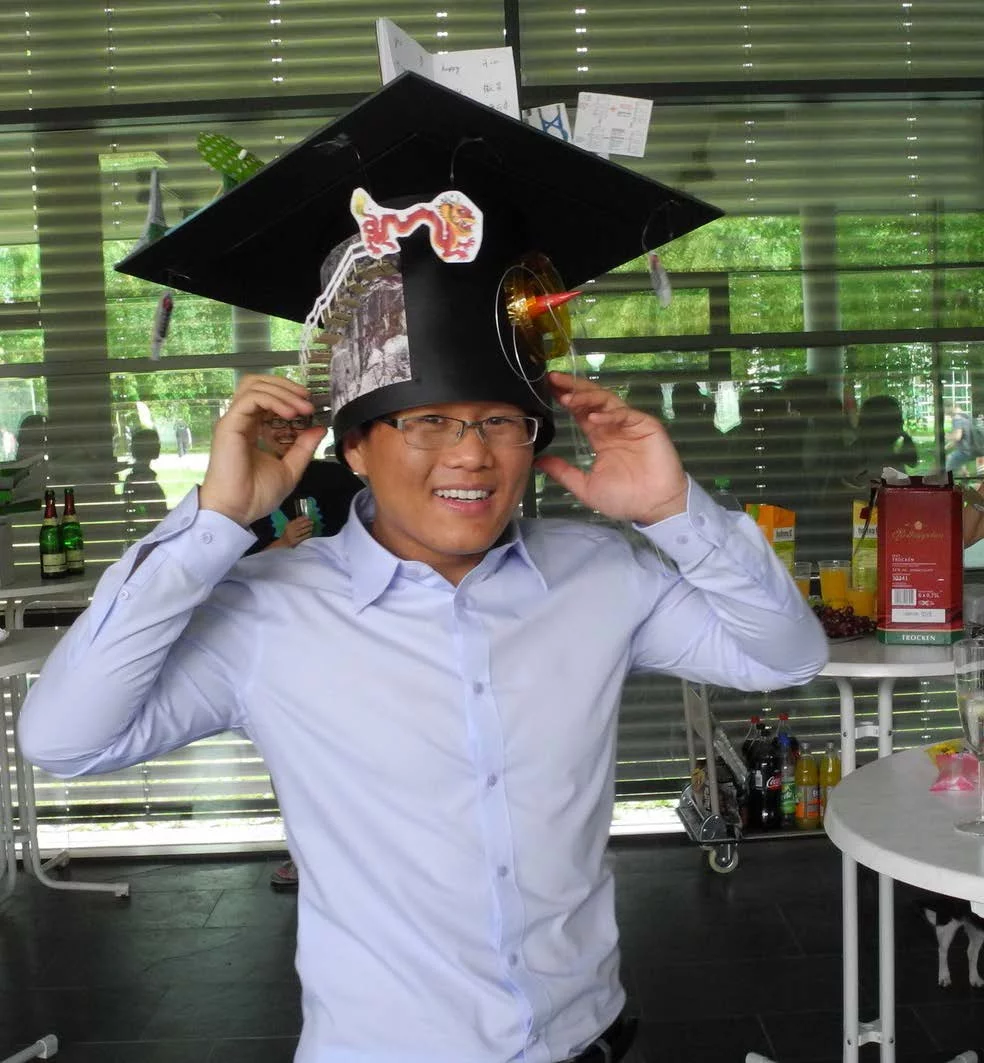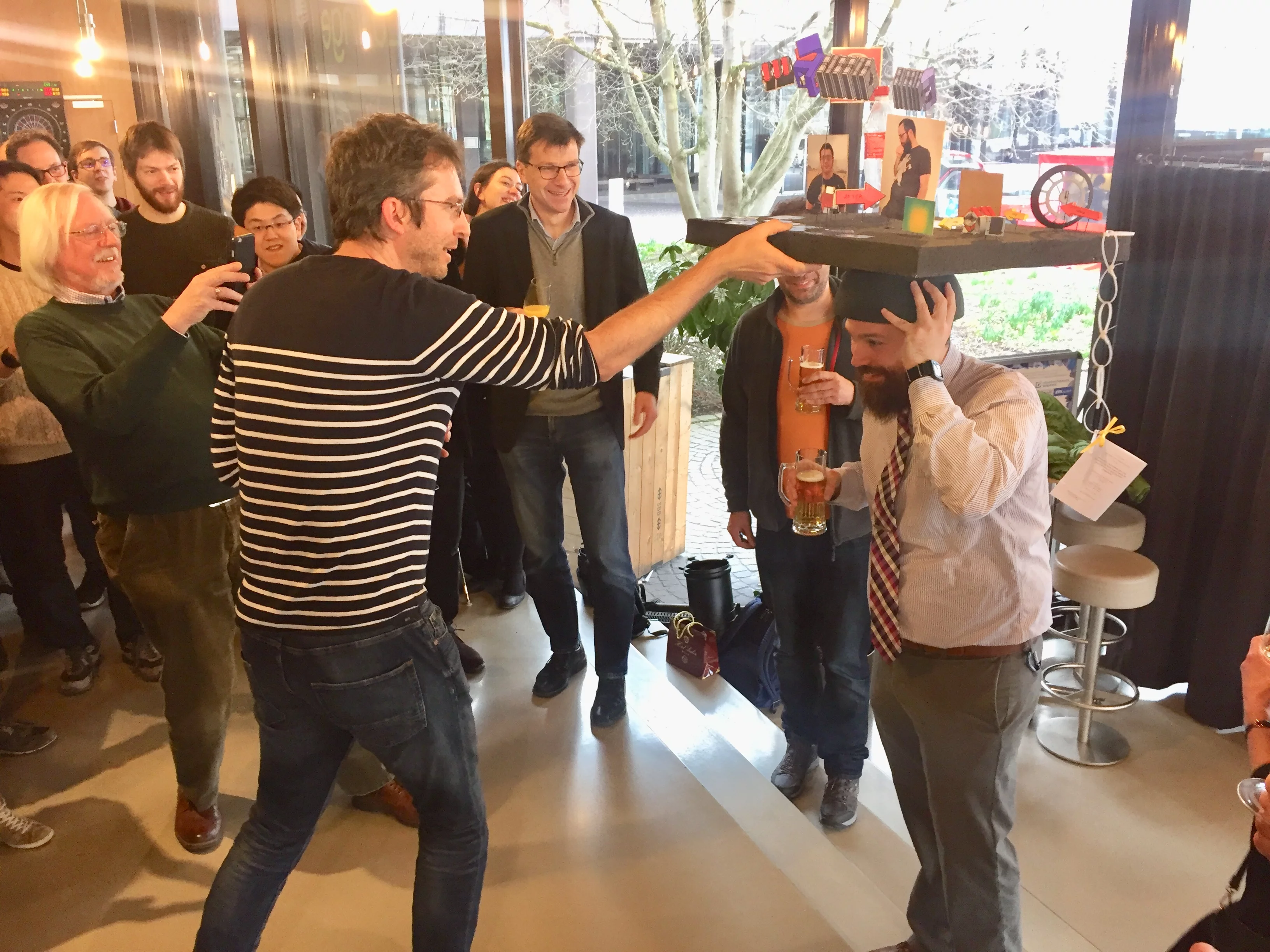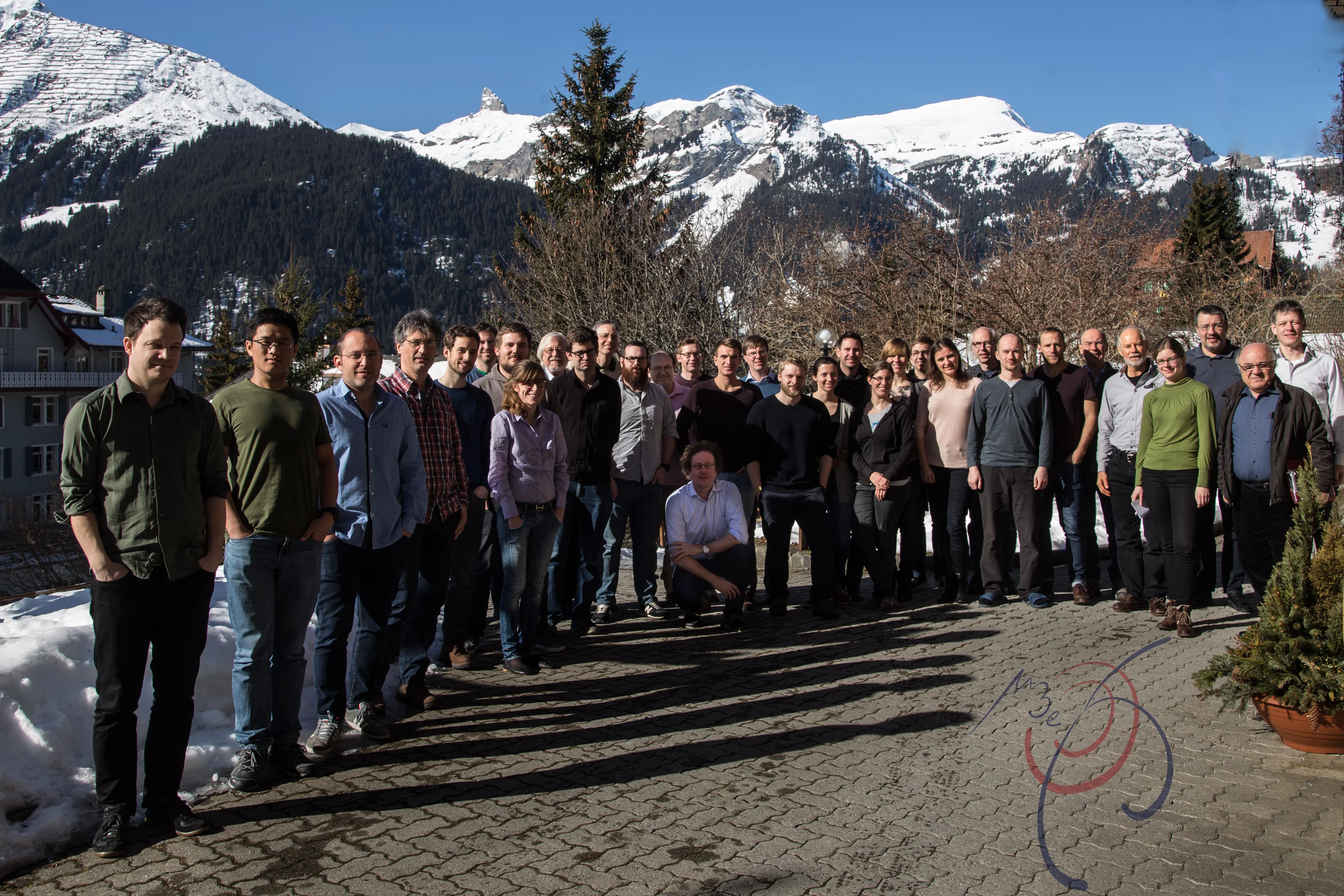Search for the lepton-flavour violating decay
$\mu^+ \to e^+ e^+ e^-$
The Mu3e experiment is a new search for the lepton-flavour violating decay of a positive muon into two positrons and one electron.
Current news
Collaboartion Meeting in Wengen
The Mu3e collaboration met four four days in Wengen. We discussed in detail the steps needed to build and integrate the detector and how to calibrate and control it. Further sessions were dedicated to on- and offline analysis of first data.
Ben Gayther successfully defends his thesis
Ben Gayther developed calibration algorithms, carried out detailed studies on the use of timing information in reconstruction, and contributed to the integration run at PSI. He has now successfully defended his thesis at University College London.
January 2024
Second Mu3e Data Challenge at PSI
The Mu3e data challeneges aim at establishing the data processing and storage procedures as well as the online monitoring tools. To this end, we use simulated data to test all involved systems and further develop the code. A first data challenege in September 2023 established the basic data flow, in the second challenge in January 2024, we added the use of databases and developed distributed monitoring code.
July 2023
Tiancheng Zhong succesfully defends his thesis
Tiancheng Zhong has contributed to the Mu3e tile detector and performed detailed irradiation studies. He has now successfully defended his thesis at Heidelberg University. The thesis is available here.
June 2023
Collaboration meeting in Bristol
The Mu3e collaboration met st the University of Bristol for three days in June. We discussed the production and assembly of the detector with a focus on the outer pixel layers and the software, firmware and infrastructure needed for the commissioning. Have a look at the picture gallery.
May 2023
Beam test of pixel sensors at MAMI Mainz
We spent a week at the MAMI electron accelerator in Mainz testing MuPix11 pixel sensors. In particular we studied the behaviour at high rates, tested various operation points and took data for parametrising the sensor response in the simulation. Have a look at the picture gallery.
March 2023
Mu3e Collaboration Workshop in Wengen
The Mu3e Collaboration met for four days in Wengen in the Bernese Alps for an intense workshop. We discussed finalizing, commissioning and calibrating the first phase of the Mu3e experiment. A lot of space was also given to developments needed for the second phase of the experiment at higher muon rates, such as very high speed pixel detectors.
May/June 2022
Cosmic Run at PSI
We assembled a Mu3e vertex detector prototype and a ribbon of the fibre detector with their associated data acquisition (DAQ) at PSI. This setup was used to develop commissioning and tuning procedures for the sensors, advance DAQ integration, develop user interfaces, check timing and finally to detect cosmic ray muons passing through the set-up. Have a look at the picture gallery.
28. April 2022
Mu3e Collaboration Meeting at PSI
After two years of virtual meetings, we held our first in-person collaboration meeting at PSI. We discussed the plans for detector construction and quality assurance, detector calibration and early physics analysis. Have a look at the picture gallery.
1. December 2021
Heiko Augustin sucessfully defends his thesis on the development of the MuPix pixel sensors
Heiko Augustin co-developed and characterised many of the MuPix pixel sensor prototypes and introduced innovative solutions for the pixel control and the reduction of on-chip cross-talk. He now defended his thesis at Heidelberg University.
24. November 2021
Mechanical Integration Mock-Up
We have built a mock-up of the detector using a mix of final mechanics and PCBs, 3D-printed models as well as cables and tubes in order to establish the assembly procedure for the experiment and make sure everything fits into the exteremely tight space. Good progress was made during the get-together in Heidelberg and also several areas for improvements were identified. Have a look at the picture gallery.
1. November 2021
Ioannis Paraskevas successfully defends his Ph.D. thesis on Mu3e commissioning
Ioannis Paraskevas commissioned the solenoid magnet and Mu3e beamline, developing simulations and carrying out measurements prior to the first Mu3e integration run. He also performed a study of fake tracks in simulation. He successfully defended his thesis during a virtual viva at University College London. Congratulations!
May/June 2021
First Mu3e Integration Run
During an extensive campaign at PSI, the Mu3e collaboration for the first time operated parts of the detector inside the experiment magnet and with muon beam stopping on a target in the center of the experiment. The pixel detector succesfully demonstarted operation with high-flow gaseous helium cooling. A slice of the final data acqusition system was employed, allowing for thorough tests of firmware and software. The beamtime was also used to optimize beam injection into the experiment solenoid. The large data set taken is being analyzed in preparation for another integration run soon.
Have a look at the picture gallery.
04. November 2020
Successful Ramp-up of the Mu3e Magnet at PSI
The Mu3e magnet has been successfully ramped up to 1T by Andreas Knecht and Ioannis Paraskevas with the remote help from Roger Mitchell from Cryogenic. This included both the main and compensation coils. It went very smoothly and no re-centering of the cryostat was necessary. The load cells showed a very balanced configuration. Congratulations to everybody involved for reaching this important milestone.
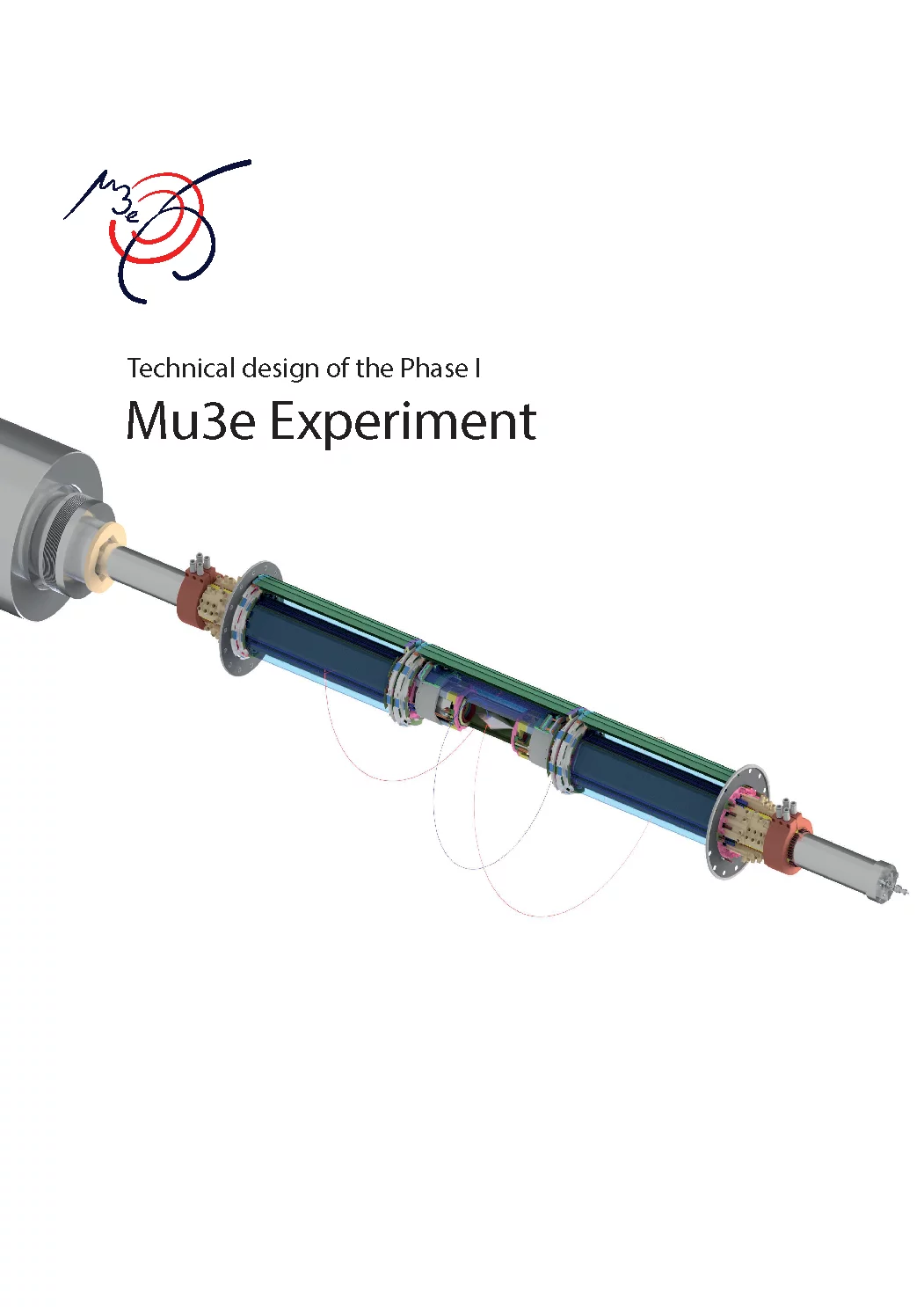
25. September 2020
Technical Design of the Phase I Mu3e Experiment published on the arXiv
In almost a decade of R&D, we have developed a detailed technical design for the Mu3e experiment, based on many new and exciting detector technologies. The technical design report for Mu3e is now available on the arXiv, check it out at https://arxiv.org/abs/2009.11690.
29. July 2020
The Mu3e Magnet arrived at PSI
14. July 2020
Beam test of the data acquisition in Mainz
Resuming beam operations, we have the opportunity to test a part of the data acquisiston sytem using the electron beam at the Mainz Microtron. We operate four pixel planes via two different front-end board prototypes to test the synchronization of across the system.
23. May 2020
The Mu3e collaboration grieves for Sig Martin.
We lost a very good friend and an important consultant for the design and construction of the magnet for our experiment.
30. April 2020
Virtual Collaboration Meeting
During the Corona crisis, meetings are only possible online. The Mu3 collaboration met today virtually with more than 20 people from three different countries.
21. February 2020
First beam test with all Mu3e subdetectors integrated
During a week of beam tests at DESY, Hamburg, we for the first time took data with the pixel, fibre and tile detectors running in a common data acquisition setup. The lessons learned are key to completion and comissioning of the complete detector readout.
8. November 2019
Second Mu3e DAQ Week in Mainz
Data Acquisition experts from all subsystems got together in the Mu3e DAQ lab in Mainz to integrate hardware, firmware and software into a common system. For the first time, we ran the full Mu3e timing and reset system and in general made good progress towards common data taking at high rates. Some pictures can be found in the gallery.
4. October 2019
Collaboration Meeting at University of Zürich
The Mu3e collaboration met for three days at University of Zürich to discuss detector integration, progress in the subsytems and plans for detector comissioning.
9. September 2019
Antoaneta Damyanova successfully defends her Ph.D. thesis on the Mu3e SciFi detector
Antoaneta Damyanova developed the scintillating fiber detector from fiber characterization to prototype construction and evaluation, SiPM array perfromance studies, and mechanical integration. She has successfully defended her thesis at Geneva University. The thesis is available here.
12. June 2019
The Mu3e collaboration grieves for Kirk Arndt.
We lost a very good friend and wonderful colleague.
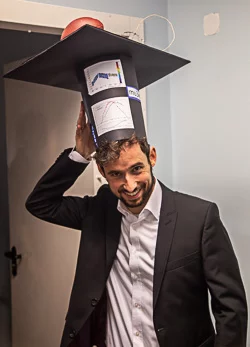
Ulrich Hartenstein successfully defends his Ph.D. thesis on track-based alignment of the Mu3e detector
Ulrich Hartenstein developed algorithms for aligning the Mu3e detector using reconstructed particle tracks. Today he successfully defended his thesis at the university of Mainz. The thesis is available here.

Meeting on Mu3e detector construction in Wengen
We spent four days in Wengen, Switzerland going over the details of the Mu3e detector and discussing the procedures for producing and integrating the sub-detectors. Safety, powering, cooling, electronics and readout were also among the topics. Some photos in the Picture gallery.
Lennart Huth successfully defends his thesis on the MuPix telescope and pixel sensor characterization.
Lennart Huth has developed the MuPix beam telescope and used it in a long series of test beams to characterize MuPix sensors. He has successfully defended his thesis at Heidelberg university. The thesis is available here.
Sebastian Dittmeier successfully defends his thesis on the Mu3e data acquisition system.
Sebastian Dittmeier has developed many important parts of the Mu3e data acquisition system, which has allowed him to perform the first successful vertical slice test of the readout system. He has now successfully defended his thesis, which also involves a study of wireless readout systems at 60 GHz, at Heidelberg university. The thesis is available here.
Collaboration meeting in Liverpool.
The Mu3e collaboration met for three days at the University of Liverpool to discuss integration and assembly of the experiment and recent progress for all subdetectors.
Simon Corrodi successfully defends his thesis on the Mu3e fibre detector.
Simon Corrodi has made important contributions to all aspects of fibre detector development, ranging from simulation and reconstruction via fibre characterization and mechanical integration to data acquisition and electronics. He has now successfully defended his thesis at ETH Zürich. The thesis is available here.
Huangshan Chen successfully defends his thesis on the development of the MuTRiG ASIC for the Mu3e timing detecors.
Huangshan Chen was instrumental in the development of the MuTRiG ASIC, which performs the time-to-digital conversion for the Mu3e fibre and tile timing detectors. He has now successfully defended his thesis at Heidelberg University. The thesis is available here.
Ann-Kathrin Perrevoort successfully defends her PhD thesis on the sensitivity of the Mu3e experiment for new physics and pixel frontend firmware.
Ann-Kathrin Perrevoort studied the sensitivity of the Mu3e experiment for the main search channel using an effective field theory approach and also simulated the performance for searches for two-body decays of the muon and electron-positron resonances. In addition she contributed a core piece of the pixel front-end firmware, namely the real-time time sorting of hits. The thesis is available here.
Zachary Hodge successfully defends his PhD thesis on the Mu3e beam line design and monitoring.
Zachary Hodge made extensive simulations for the Mu3e muon beam line at PSI, including some upgrade of the muon target E at PSI, which is supposed to improve the muon beam rate significantly. He co-developed a monitoring scheme using a scintillating target and a CCD camera for beam characterization and monitoring. The thesis is available here.
Meeting on Mu3e detector integration in Wengen
We spent four days in Wengen, Switzerland going over the details of the Mu3e detector integration and discussing the procedures for producing the sub-detectors. Safety, powering, cooling, electronics and readout were also among the topics.
Review of Mu3e at PSI
Mu3e has passed a detailed review at the PSI proton accelerator users meeting. Beam time in 2018 was granted for tests of the timing and pixel detectors as well as for further development of the compact muon beam line (CMBL).
Dorothea vom Bruch successfully defends her Ph.D. thesis on the Mu3e filter farm and MuPix timing behaviour
Dorothea vom Bruch developed and implemented the algorithms for the Mu3e filter farm, showing that just 12 PCs with powerful GPUs are sufficient to reduce over 10 Gbyte/s of data to manageable levels. She also performed detailed studies of the position dependent timing behaviour of the MuPix7 HV-MAPS prototype. She has now successfully defended her thesis in Heidelberg. The thesis is available here.
First MuPix8 beam test at DESY
We are testing our new large sensor chip, the MuPix8, in the electron beam at DESY, Hamburg. One of the high resolution EUDET telescopes serves as a reference for efficiency and resolution measurements.
Collaboration meeting in Mainz and new collaborators
In a two day meeting in Mainz we had the pleasure of welcoming four new institutes, namely the universities of Liverpool, Oxford and Bristol as well as University College London to the collaboration. We also discussed progress on all subdetectors and a variety of integration issues.
MuPix8, our first large sensor, has arrived
We have just received first samples of the MuPix8 chip from the foundry. This is our first large (20mm x 10mm) pixel sensor prototype and a big step on the way to building the Mu3e tracking detector. The prototype will now be thoroughly tested in the labs in Karlsruhe and Heidelberg and will also soon see first beam at DESY in Hamburg, PSI and MAMI in Mainz.
Felix Berg successfully defends his Ph.D. thesis on the Compact Muon Beam Line (CMBL) for Mu3e
Felix Berg has developed a full simulation of the high intensity, compact muon beam line for Mu3e. Beam tests he performed in the piE5 area have validated his simulations and established the beam setup for phase I of Mu3e. He has successfully defended his thesis at ETH Zürich. The thesis is available here.
Meeting on future directions with Mu3e in Wengen
We spent four days in Wengen, Switzerland, discussing ideas for physics with the Mu3e apparatus beyond the search for the lepton-flavour violating decay of the muon to three electrons. Collaboration members and theorists presented new ideas for future measurements with the high acceptance, high resolution Mu3e spectrometer using high intensity muon and pion beams at PSI. Technical challenges and promising R&D directions related to high-intensity data taking were also discussed in detail.
